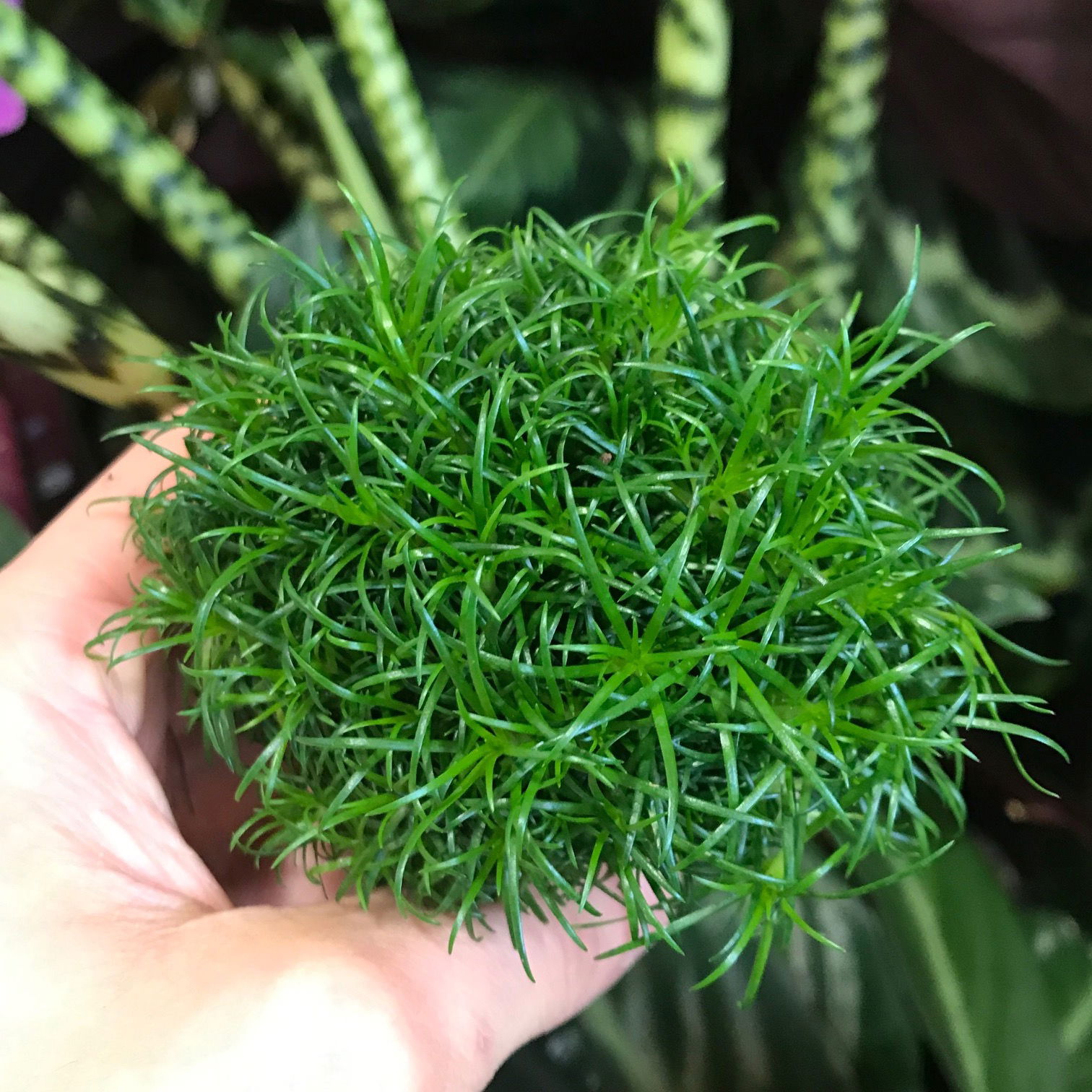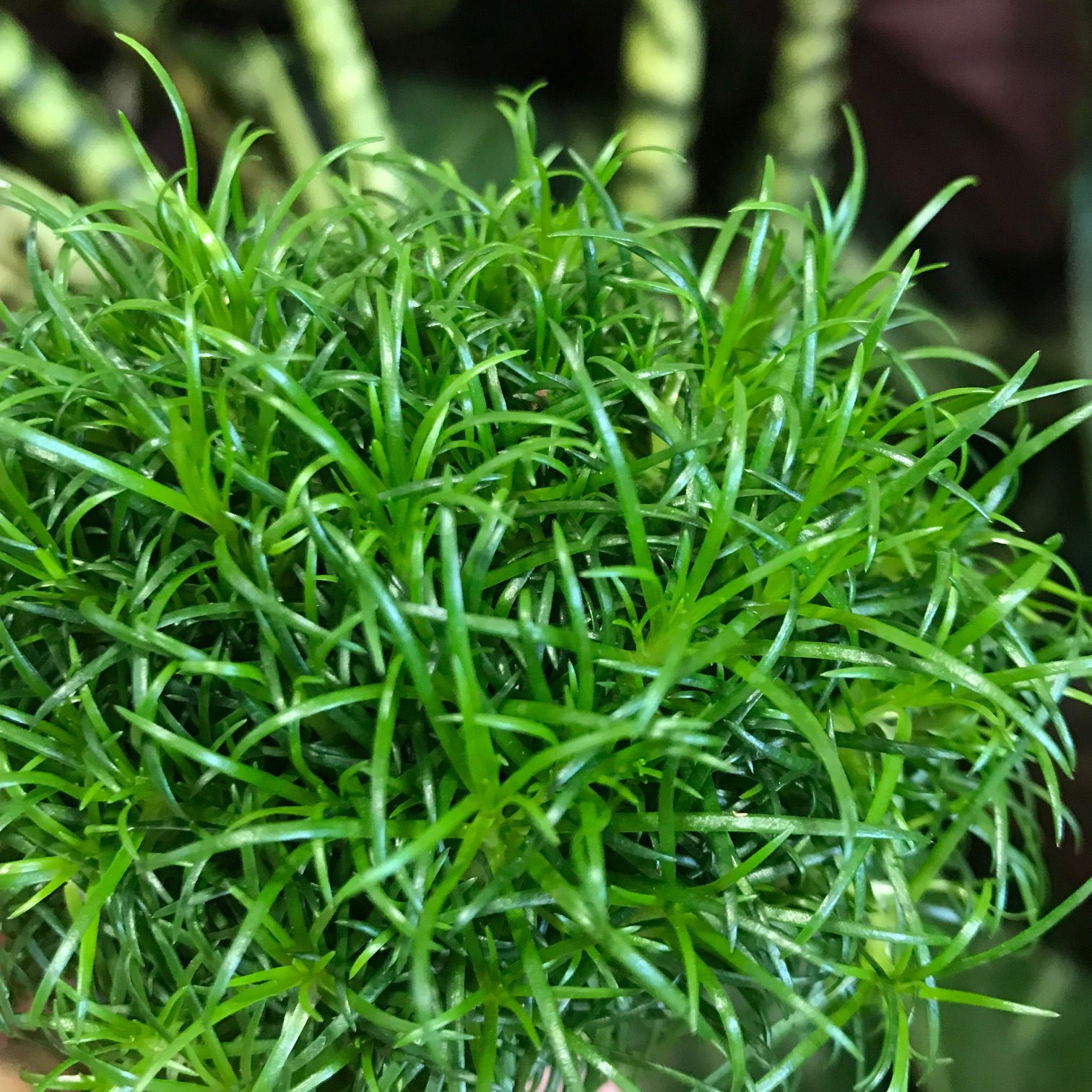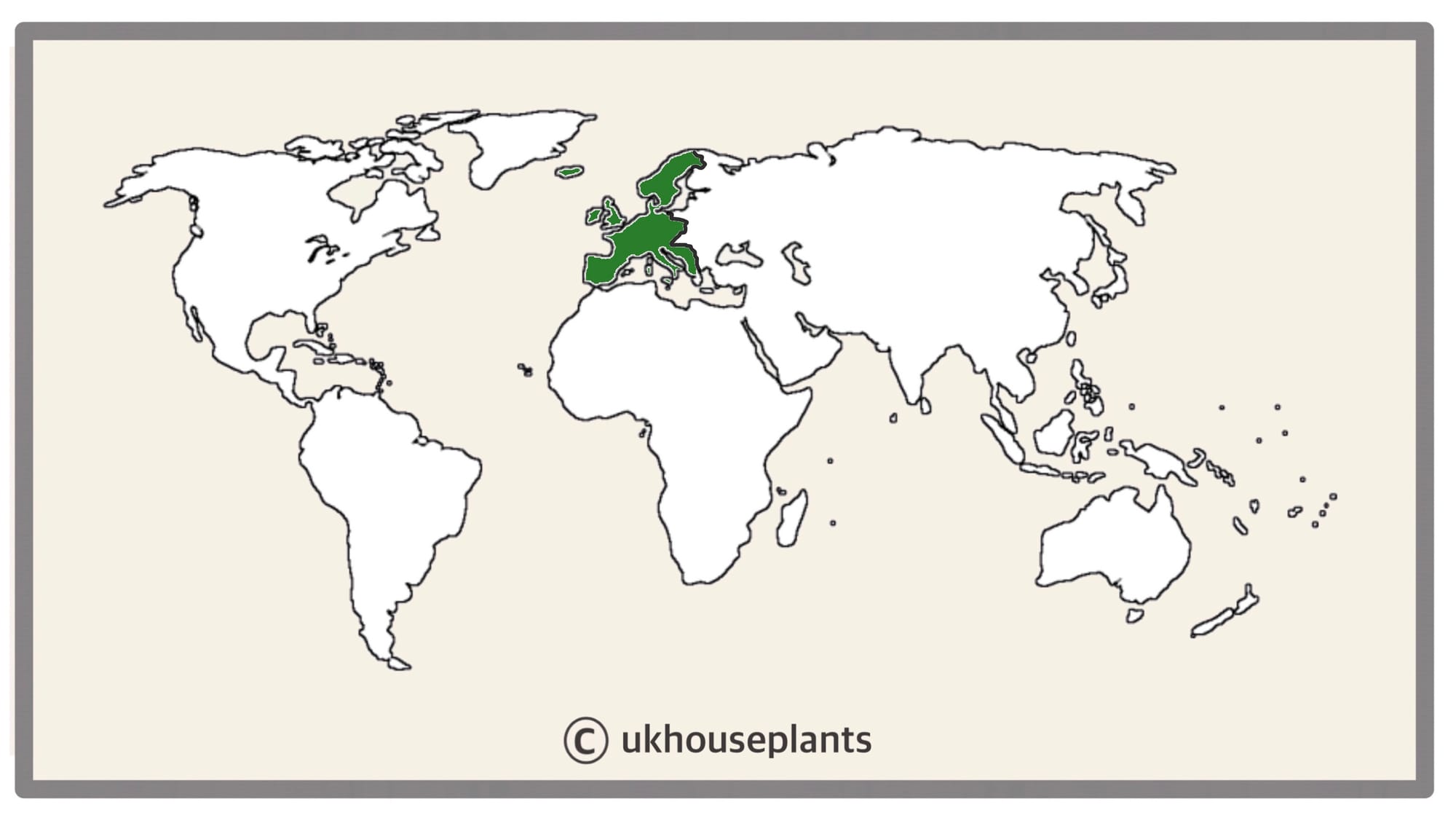
Sagina hawaiensis 'Supreme' (Formally known as 'Sagina subulata').
Contents
- Top Tips
- Location, Water, Humidity & Fertilisation
- Common Issues
- Origins, Temperature, Propagation, Repotting & Toxicity
Need the answer to a specific plant query? Book a 1-to-1 video call with THE HOUSEPLANT DOCTOR™, the website's friendly author, to overcome and address your niggling problem! Available on iMessage, WhatsApp, Facebook Messenger & more.
Top Tips & Info
- Care Difficulty - Easy (When kept in reliably moist soil)
- Irish Moss Plants can die shortly after flowering which is a natural process and doesn't mean you're a bad plant parent.
- This species likes a bright, indirect location away from the risk of operating heat sources or direct sunlight. Always keep the specimen at least three metres from a heater or active fireplace.
- Maintain evenly moist soil using the bottom-up method of submersion. Allowing excess moisture to sit in the cubbyholes of the foliage may result in rot or southern blight.
- Provide a humid location by introducing a humidity/pebble tray.
- Fertilise using a 'Houseplant' labelled feed every four waters in the spring and summer, reducing this to every six in the colder months.
- Pests aren't as much of an issue with Irish Moss, however, have a quick scan for Aphids that'll attack the juvenile growths in the spring, if situated near a window.
- Repot every three years using a 'Houseplant' potting mix - this is a perfect time to propagate.
- Irish Moss tends to grow more efficiently when situated in shallow, wide pots to complement its horizontal growth habits. Have a search at your nearest garden centre for terracotta bulb bowls that'll be located in the outdoor pot department. Alternatively, 'tot' specimens in a 5cm pot (available at Blue Diamond stores in the U.K.) are perfect for tropical-themed terrariums or displays due to its ability to quickly cover bare soil.
Location & Light - 🔸🔸
Irish Moss will favour a relatively warm location, with exposure to bright, indirect light. It's essential not to situate yours in deep shade as the risk of older leaves beginning to yellow and rot could increase. If you're worried about its location being too dark, if a newspaper can be read while having your back towards the light source, you're good to go! Avoid more than an hour of sunlight per day due to the heightened risk of sun-scorch.
Water - 🔸🔸🔸
The most challenging part of caring for Irish Moss is providing near-continuous soil moisture with the avoidance of persistent droughts. We'd recommend hydrating once or twice a week to ensure thorough saturation. Water your specimen using the bottom-up method, as excess moisture that settles in the plant's centre could cause the central leaves to rot, leaving you with a naked base. Under-watering symptoms include a gradual decline in foliage size, crispy leaves and stunted growth, which are usually due to forgetfulness or too much heat/sunlight. Over-watering symptoms include a rotten root ball, lower leaves turning yellow and plant death. Never allow the plant to sit in water for long periods, primarily if it's situated in a shady spot. Prolonged saturation will enable mould to develop on the soil, along with the heightened chance of root rot. Click on the link to find out more about addressing these issues.
Humidity - 🔸🔸
Saturated air is essential to compliment the longevity of moist soil. Introduce a pebble tray to provide a humid, reliable environment for your Irish Moss to thrive in; too dry air will cause its foliage to crisp up, as well as the increased chance of browning leaf-edges. The tray will also act as a buffer for dehydration, as the Moss will absorb moisture through its leaves if it senses drier times ahead.
Fertilisation - 🔸
Feed every four waters during the growing period and every six in the autumn and winter, using a 'Houseplant' labelled fertiliser. Never apply a 'Ready to Use’ product into the soil without a pre-water first, as it may burn the roots and lead to yellowed leaves.
 Because of the species' soft-matted properties, Irish Moss is excellent for Tropical Terrariums.
Because of the species' soft-matted properties, Irish Moss is excellent for Tropical Terrariums.
Common Issues with Irish Moss (Sagina)
In some cases, Irish Moss plants are only annual, meaning that they'll die shortly after flowering by turning yellow and limp. Don't worry if this happens with yours as this is nothing to do with your growing skills!
Under-watering is the biggest issue that indoor gardeners will face. Typical signs include wilting, sunken or yellowed leaves and stunted growth. If the specimen receives even a hint of direct light - relocate it. The increased temperatures and sun exposure will significantly speed the process of dehydration, which in turn will result in inevitable death. Irish Moss cannot survive in drought-like conditions, so providing a bright, indirect setting with an abundance of moisture is paramount for quality growth. Those situated in direct sunlight or within three metres of a radiator are most likely to suffer from dehydration.
When a specimen is severely dehydrated, most of its leaves will crisp-up and fall off - leaving you with a naked plant. Although it may spell the end of juvenile plantlets, there may still be light at the end of the tunnel for more established specimens. If its stem is still plump without any signs of retraction, prune-away the severely affected areas and contain the plant (with its pot) in a transparent bag that has small holes. Keep the soil continually moist, providing a good level of indirect light and temperatures above 15°C (59°F). Remove from the bag after two months of solid foliar growth.
Never situate it within four metres of an operating heat source, for instance a radiator or fireplace. Due to the heightened temperature and dry air, the plant will soak up far more moisture than those situated in cooler locations, increasing the chance of dehydration and browning leaf-tips.
As mentioned before, basal rot & southern blight are major threats among heavy foliage plants when excess moisture is allowed to sit on compacted foliage. Remove the affected areas and improve the growing conditions by situating the plant in a brighter location and keeping the leaves dry.
Too low humidity can cause browning leaf tips with yellow halos. Although this won't kill your specimen, you may want to increase the local moisture to prevent the new growth from adopting these symptoms. Mist or rinse the foliage from time to time and create a humidity tray whilst the heaters are active to create a stable environment for your specimen.
Yellowing lower leaves (closest to soil) are a clear sign of over-watering, usually caused by too little light. Although they can do well in darker locations, the frequency of irrigations must be reduced to counteract the chance of root rot. People don't realise that a plant's root system needs access to oxygen too; when soil is watered, the air will travel upwards and out of the potting mix. A lack of accessible oxygen for the roots will cause them to subsequently breakdown over the oncoming days. Click on this link to learn more about root rot and how to address it, and always feel the pot's weight for confirmation (heaviness = good soil moisture, & vice versa).
Curled leaves and brown leaf-edges are the result of too little water and over-exposure to the sun. Irish Moss are best located in bright, indirect settings, and those that haven't acclimatised to the harsh rays will show signs of sun-scorch and environmental shock. A splash of winter sunlight is acceptable as long as the soil moisture is regularly observed, with complete avoidance once summer comes along.
Origins
Carl Borivoj Presl first documented the species in the first half of the 19th century, placing it in the already-constructed genus, Sagina, by Carl Linnaeus. The species' name was originally 'Sagina subulata' until Ferdinand Albin Pax reclassified it as 'Sagina hawaiensis' in the early 20th century. The meaning behind Sagina is largely unknown, whereas 'Subulata' refers to the thin and pointed edges of its leaves. 'Hawaiensis' is a specific epithet describing a species' distribution to the islands of Hawaii, despite the mentioned species being endemic to Europe.
 The Distribution of Sagina hawaiensis.
The Distribution of Sagina hawaiensis.
Temperature
5° - 26°C (40° - 80°F)
H1c (Hardiness Zone 11) - Can be grown outdoors between late spring and summer throughout most of the UK while nighttime temperatures are above 8℃ (46℉). If you decide to bring the plant outdoors, don't allow it to endure any periods of direct light as it may result in sun-scorch. Regularly keep an eye out for pests, especially when re-introducing back indoors.
Spread
Up to 40cm in height and 1m in width once they reach maturity; the ultimate height will take between 3 - 6 years to achieve with 10cm of new growth per season.
Pruning & Maintenance
Remove yellow or dying leaves, and plant debris to encourage better-growing conditions. While pruning, always use clean scissors or shears to reduce the chance of bacterial and fungal diseases. Never cut through yellowed tissue as this may cause further damage in the likes of diseases or bacterial infections. Remember to make clean incisions as too-damaged wounds may shock the plant, causing weakened growth and a decline in health.
Propagation
Via Seed or Division.
Division (Easy) - In spring, split the root ball into quarterly sections that house a good amount of foliage and roots. Dividing too-small segments of the rootball could lead to transplant shock or unsuccessful propagation. Sections that are at least 3cm (1.5 inches) in diameter serve the best chance of propagation due to the stored energy in the roots and stems. Place the sections into 'Houseplant' compost and water regularly, avoiding prolonged sunlight or persistent droughts.
Flowers
Irish Moss will produce insignificant perennial flowers that sport either a white appearance, just above the foliage line. The blooming period will last up to a month or two during late spring to early summer. In most cases, an Irish Moss will die shortly after flowering as the species is horticulturally classed as an 'annual'.
Repotting
Repot every three years in spring using a 'Houseplant' labelled compost and the next sized pot with adequate drainage. As Irish Moss are ground creepers, they tend to grow quicker in a wide, shallow pot; visit your local garden centre and search for 'Terracotta Bulb Bowls' which should be on sale all year round. Hydrate the plant 24hrs before tinkering with the roots to prevent the risk of transplant shock. For those that are situated in a darker location, add a thin layer of small grit in the pot's base to improve drainage and downplay over-watering.
Click here for a detailed step-by-step guide on transplantation, or via this link to learn about repotting with root rot.
Pests & Diseases
Although pests aren't usually an issue when cultivating Irish Moss, fungus gnats or aphids may attack weakened specimens with overly moist soil. Common diseases are root rot, botrytis, rust, powdery mildew and southern blight - click here to learn more about these issues.
Toxicity
Not known to be poisonous by consumption of pets and humans. If high quantities are eaten, it may result in vomiting, nausea and a loss of appetite.
Retail Locations
Blue Diamond, Online Stores.
Book a 1-to-1 Call with THE HOUSEPLANT DOCTOR™
If you need further advice with your houseplants, book an advice call with ukhouseplants' friendly and expert writer today! This can be done via a video or audio call on most apps, including Facebook, FaceTime & Skype. A ten-minute call costs £5.99 (US$7), or £15.99 for thirty minutes. You can ask multiple questions, including queries on plants, pests, terrariums, repotting advice and anything in between. Please consider supporting this service to keep ukhouseplants thriving!